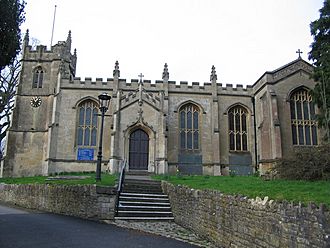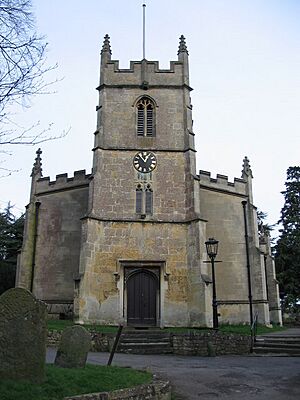All Saints' Church, Weston facts for kids
- For the church with a similar name in Cheshire, see All Saints' Church, Weston, Cheshire
- For the church with a similar name in Nottinghamshire, see All Saints' Church, Weston, Nottinghamshire
Quick facts for kids All Saints |
|
|---|---|
 |
|
| General information | |
| Architectural style | Victorian |
| Town or city | Weston, Bath |
| Country | England |
| Construction started | 15th century |
| Completed | 1832 |
| Design and construction | |
| Architect | John Pinch the Elder |
All Saints' Church is a Church of England parish church located in Weston, a small village near Bath, England. This church has stood on a hill for over 800 years! The current church was designed by architect John Pinch the Elder. It was finished in 1832. However, it still has the old tower from the 1400s. This old tower belonged to the church that was here before, called All Hallows Church.
Contents
Exploring the Churchyard
The churchyard is the area around the church where people are buried. It has more than 90 stone tablets and memorials. Some of these go all the way back to the 1100s! The church kept very good records. These records show that many people buried here did not live in Weston. They chose this peaceful spot because it was quiet and far from the busy city of Bath. This quiet churchyard was popular for over 200 years.
The First Church: Medieval Times
The very first church here was mentioned by Pope Adrian IV in 1156. The first vicar, Jordanus, arrived in Weston in 1297. In the 1400s, a church called All Hallows Church was built. But in 1830, this church was taken down. This was done to make space for a bigger church, as the community was growing. Only its tall tower was kept.
The church bells were made new in 1739 by the Bilbie family. They were fixed and tuned again between 1952 and 1953. Today, the tower has six bells from 1739. It also has two newer bells from 1952.
The Victorian Church Building
The new All Saints' Church was officially opened on June 2, 1832. It looks a bit like other churches designed by John Pinch. These include St. Mary the Virgin in Bathwick. However, those churches were built from scratch. All Saints' kept its old tower.
Between 1880 and 1893, new seating was added. New parts for the church, called transepts and a chancel, were also built. In 1909, new rooms for the clergy (church leaders) and choir were added. The inside of the church has been changed and updated many times since then. Recently, the old tower was also repaired. Near the tower door, you can see a font from the 1800s. A font is a large basin used for baptisms. On the West Gallery, you can see the royal coat of arms of William and Mary.
In 1955, the church was given a special status. It was named a Grade II listed building. This means it is an important historic building that needs to be protected.
Special Things to See
The church has many interesting features. On the south side, there is a special window called the St Alphege window. This window remembers a famous saint. People believe St Alphege was born in Weston. He later became the head of Bath Abbey and then the Archbishop of Canterbury. The window also shows King Guthram of the Danes. He is shown accepting Christianity from King Alfred.
In the south transept, there is a monument from 1641. It honors Alderman Sherston, who was the Mayor of Bath in 1632. In a special spot on the north wall, you can find the oldest monument in the church. It is a stone coffin lid from the 1100s or 1200s. This lid was found under the south porch when the church was rebuilt in 1830. Other monuments include one from 1699 for John Harrington. There is also a monument for Dr William Oliver. He was famous for his biscuits! His family owned Weston Manor for many years.
Images for kids



